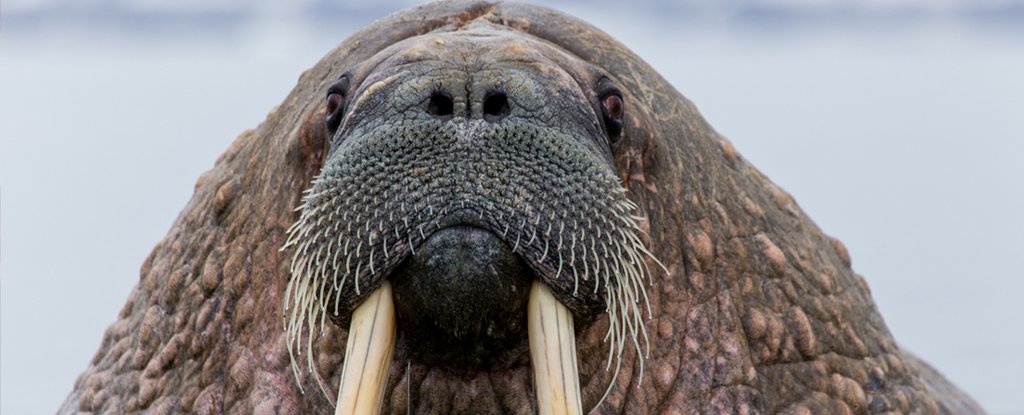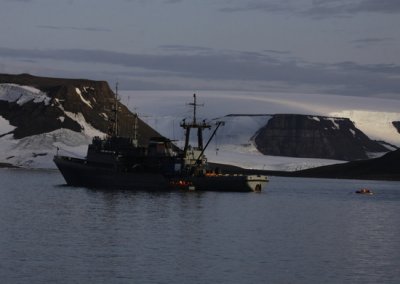
+- WildFact (https://wildfact.com/forum)
+-- Forum: Information Section (https://wildfact.com/forum/forum-information-section)
+--- Forum: Terrestrial Wild Animals (https://wildfact.com/forum/forum-terrestrial-wild-animals)
+---- Forum: Carnivorous and Omnivores Animals, Excluding Felids (https://wildfact.com/forum/forum-carnivorous-and-omnivores-animals-excluding-felids)
+---- Thread: Walrus (Odobenus rosmarus) (/topic-walrus-odobenus-rosmarus)
Pages:
1
2
Walrus (Odobenus rosmarus) - Polar - 03-15-2018
Walrus saying hello to humans.
RE: Walrus (Odobenus rosmarus) - Polar - 03-15-2018
One of the world's toughest, if not the toughest, predators (or prey depending on how you look at them) in existence, walruses are equipped with one of nature's thickest hides and blubber layer, equipped with dense tusks, a giant muscular body, and skeletons much denser than most giant land herbivores. They are the hardest prey to kill, much like a tank that stabs instead of shoots cannons. Extremely agile for their size too, and with one swift motion can paddle themselves across land almost at the speed of Usain Bolt.
Humongous male polar bears have extreme trouble even dealing with a younger female walrus, even by ambush, and that is a testament to how tough these creatures are. Walruses, much like bison or cape buffalo, also have numbers on their side as well; they are extremely social creatures especially around the midst of summer and breeding seasons and polar bears normally hunt at maximum during summer.
RE: Walrus (Odobenus rosmarus) - Polar - 03-15-2018
Even a adult male polar bear has big trouble with a younger female walrus, can't even penetrate the skin with its tough jaws or even control the waterbeast:
RE: Walrus (Odobenus rosmarus) - Polar - 03-15-2018
Walruses always have each other's back, as shown in the following photo:

*This image is copyright of its original author
RE: Walrus (Odobenus rosmarus) - Polar - 03-15-2018
Walruses coming ashore
Credits to WWF Arctic
"IT HAS LONG BEEN surmised that as the Arctic warms and sea ice recedes, more polar bears will spend longer time on shore throughout their range. This is supported by recent research using movements data from polar bears in the Southern Beaufort and Chukchi Seas along with anecdotal reports of increased sightings and encounters.
Much thought and some new projects have focused on what this likely means for conflict between people and polar bears, while other research has also highlighted the potential impacts to shore dwelling birds and bears. Less thought has been given to the potential impacts on other marine mammals such as walrus who are also increasingly forced to spend more time on land. Pacific walrus have shown signs of shifting distribution with historically large or new haulouts reported in both Chukotka and Alaska. While use of land is nothing new, traditionally these haulouts were composed of males, the haulouts were much smaller in size, and were not dominated by females and calves as is now the case. This is entirely new and likely tied to the retreat of sea ice beyond the productive continental shelf – a key feature of the vast and relatively shallow Chukchi Sea that defined this largely benthic system for decades if not millennia. When walruses are at sea and using the ice as a resting and rearing platform, they tend to occur in lower numbers and are continuously in motion with the sea ice, distributing their foraging across the Chukchi. As lack of sea ice forces the animals ashore, the new haulouts can number 20,000- 70,000 individuals or more.
On land and in herds of this size, walruses are prone to stampede events that endanger young and old, resulting in increased mortality of females and new calves. The presence of walrus and of carcasses is a strong attractant for polar bears. These species have evolved together in a sea ice dominated system but an adult male walrus can more than match most polar bears with its size, strength, incredibly tough hide, and dangerous tusks. They can and do mortally injure polar bears so it is common to see bears showing deference to adult walrus. As with seals and small whales, in open water the advantage goes clearly to the walrus. Young, injured, or sick walrus are another matter and can easily fall prey to a savvy bear while carcasses from stampede events or other natural mortalities can provide a veritable bounty for polar bears lucky enough to encounter them along the coast.
I have had the fortune to observe polar bears and walrus within meters of one another on more than one occasion while working in the Russian Arctic. In one situation, an incredibly well fed male polar bear was feasting on carcasses adjacent to a haulout estimated at over 80,000 animals. Neither the bear or the living walrus appeared to pay one another much attention, though I imagine the walrus, mostly females and calves, were keeping a watchful eye. In both other cases, the herds were smaller and the haulouts more traditional: adult males dominated the use of land while females and younger walrus stayed close to or in the water, at least when a bear was present. At both sites, an adult male polar bear could simply walk up to within a few meters of the male walrus and lie down and observe, likely assessing the situation for any easy targets, but an attempted predation was not observed. So what can we expect as more polar bears and more walrus spend more time ashore? Likely more skirmishes as either inexperienced bears, or those in poor shape, take more risks in attempts to secure food.
A small number of polar bears will also benefit greatly from increased carcass availability. However, the greatest threat to both species will remain the loss of sea ice habitat. As the Arctic continues to warm at a pace more than double that of the global average, the fundamental ecosystem that walrus and polar bears evolved to exploit is being pulled out from under them. This exposes both species to increased foraging costs, factors that decrease reproductive success, and that increase mortality: fundamental shifts to the ecosystem itself; new disease vectors; and competition from what were historically southern species. The last walrus will not likely be taken by the last polar bear, rather they will both be greatly reduced in range and numbers unless warming and subsequent loss of sea ice can be stabilized or reversed."
RE: Walrus (Odobenus rosmarus) - Polar - 03-15-2018
Personal tale...when I went up to Churchill, Manitoba back in 2014 as part of my second WWF Arctic Expedition trip, the two guides that toured the trip stated that walruses emit a constant smell of butter, rotten meat decay, and unclean sweat at all times. He said that, even at no closer than 100 feet from a large female walrus, that he could smell that exact smell. I have never experienced the smell personally, but I am pretty sure I don't want to after hearing his description of the smell.
RE: Walrus (Odobenus rosmarus) - Polar - 03-15-2018
Another attempt of a polar bear trying to hunt a walrus. Notice how the bear tries to top-control the waterbeast by forcing it down on the ground...another testament of a smaller walruses' strength around the 0:36 to 0:50 minute mark. Even smaller-sized polar bears of more than 600-pounds can easily break through a meter-thick ice layer to obtain prey, but the similar motion is simply ignored by the walrus as it easily waddles to the water surface. I am pretty sure even a bigger male polar bear would have extreme trouble controlling the walrus.
RE: Walrus (Odobenus rosmarus) - Polar - 03-15-2018
Even a starving mother bear won't mess with a healthy walrus (looks like a smaller male, even), and when in starvation mode, mother bears and hungry bears will hunt anything...except for walruses. Even a sick walrus can prove a large problem!
RE: Walrus (Odobenus rosmarus) - Pckts - 03-15-2018
(03-15-2018, 07:38 PM)Polar Wrote: Even a starving mother bear won't mess with a healthy walrus (looks like a smaller male, even), and when in starvation mode, mother bears and hungry bears will hunt anything...except for walruses. Even a sick walrus can prove a large problem!
Why would she?
She has a cub to protect and feed, she'd have to be crazy to mess with one of those monsters!
It still amazes me that Polar bears can prey on these creatures as it is, I find Walrus as impressive and tough as any prey taken by a lone predator. They may not be agile but they are massive, covered in protective fat and have huge tusks with no real vital points. Only way to kill one is a long and drawn out battle.
RE: Walrus (Odobenus rosmarus) - brotherbear - 03-15-2018
Some older posters might remember Jacques-Yves Cousteau.
I used to watch his documentaries regularly. He told once of witnessing an Orca vs walrus battle at sea. He described a relatively long-lasting bloody battle in which the walrus was finally killed, but whether or not the Orca would survive his wounds was indefinite.
RE: Walrus (Odobenus rosmarus) - Polar - 03-15-2018
(03-15-2018, 08:39 PM)Pckts Wrote:(03-15-2018, 07:38 PM)Polar Wrote: Even a starving mother bear won't mess with a healthy walrus (looks like a smaller male, even), and when in starvation mode, mother bears and hungry bears will hunt anything...except for walruses. Even a sick walrus can prove a large problem!
Why would she?
She has a cub to protect and feed, she'd have to be crazy to mess with one of those monsters!
It still amazes me that Polar bears can prey on these creatures as it is, I find Walrus as impressive and tough as any prey taken by a lone predator. They may not be agile but they are massive, covered in protective fat and have huge tusks with no real vital points. Only way to kill one is a long and drawn out battle.
Correct. And even then during the long run, the bear usually just gives up because the walrus is simply indestructible...or the bear attempts to eat chunks of flesh from the walrus while it is still alive. Many wild dogs do the latter when hunting large prey such as bison or moose, they sometimes tear chunks off of it while it's still alive.
RE: Walrus (Odobenus rosmarus) - Spalea - 11-20-2019
Big boy !
Svalbard: archipelago of Norway.
RE: Walrus (Odobenus rosmarus) - BorneanTiger - 11-26-2019
(03-15-2018, 07:12 PM)Polar Wrote: Walruses always have each other's back, as shown in the following photo:
*This image is copyright of its original author
... Unless a bunch of bears do this smartly:
RE: Walrus (Odobenus rosmarus) - BloodyClaws - 03-18-2020

*This image is copyright of its original author
NATURE
Walruses Have Attacked And Sunk a Russian Navy Boat in The Arctic

*This image is copyright of its original author
RYAN PICKRELL, BUSINESS INSIDER
24 SEPTEMBER 2019
In a kind of odd man-versus-nature moment, a Russian navy boat was attacked and sunk by a walrus during an expedition in the Arctic, the Barents Observer reported Monday.
The Altai, a tugboat of the Russian navy's Northern Fleet, sailed to the Franz Josef Land archipelago in the Arctic carrying researchers from the Russian Geographical Society.
"The polar latitudes are fraught with many dangers," the research group posted in a recent press update.
One of those dangers is apparently walruses, a monstrously large animal that can weigh up to a few thousand pounds and can be quite ferocious when threatened.
To get ashore from the Altai, the researchers and other expedition participants had to rely on smaller landing craft.
During one landing, the "group of researchers had to flee from a female walrus, which, while protecting its cubs, attacked an expedition boat," the Northern Fleet said.
The navy added that "serious troubles were avoided thanks to the clear and well-coordinated actions of the Northern Fleet service members, who were able to take the boat away from the animals without harming them."

*This image is copyright of its original author
The Altai. (Russian Ministry of Defence)
The Barents Observer reports that a drone was being operated in close proximity to the walruses. It is unclear if this is what triggered the aggression.
While the Russian military makes no mention of any equipment losses, the Geographical Society had a bit more to say on what happened.
"Walruses attacked the participating boat," the research group explained. "The boat sank, but the tragedy was avoided thanks to the clear actions of the squad leader. All the landing participants safely reached the shore."
This wasn't the Russian navy's first run-in with walruses.
This past May, photos believed to be from 2006 surfaced online of a large walrus napping on top of a Russian submarine.
https://www.sciencealert.com/a-walrus-attacked-and-managed-to-sink-a-russian-navy-boat-in-the-arctic
RE: Walrus (Odobenus rosmarus) - Spalea - 06-02-2020
Thomas Vilayan: " Big boy in Svalbard ! "